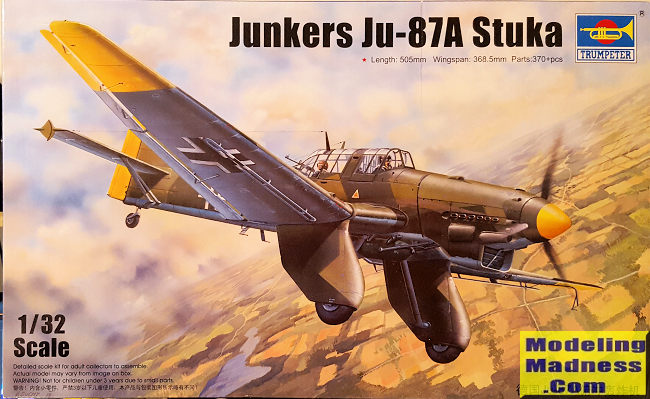
Trumpeter 1/32 Ju-87A Stuka
| KIT #: | 03213 |
| PRICE: | $60.00 or so |
| DECALS: | Two options |
| REVIEWER: | Scott Van Aken |
| NOTES: | 2014 release |

| HISTORY |
The second prototype had a redesigned single vertical stabiliser and a 610 PS (601.7 hp; 448.7 kW) Jumo 210 A engine installed, and later the Jumo 210Da. The first A series variant, the A-0, was of all-metal construction, with an enclosed cockpit under a "greenhouse" well-framed canopy; bearing twin radio masts on its aft sections, diagonally mounted to either side of the airframe's planform centreline and unique to the -A version. To ease the difficulty of mass production, the leading edge of the wing was straightened out and the ailerons' two aerofoil sections had smooth leading and trailing edges. The pilot could adjust the elevator and rudder trim tabs in flight, and the tail was connected to the landing flaps, which were positioned in two parts between the ailerons and fuselage. The A-0 also had a flatter engine cowling, which gave the pilot a much better field of vision. In order for the engine cowling to be flattened, the engine was set down nearly 0.25 m (9.8 in). The fuselage was also lowered along with the gunner's position, allowing the gunner a better field of fire.
The RLM ordered seven A-0s initially, but then increased the order to 11. Early in 1937, the A-0 was tested with varied bomb loads. The underpowered Jumo 210A, as pointed out by von Richthofen, was insufficient, and was quickly replaced with the Jumo 210D engine.
The A-1 differed from the A-0 only slightly. As well as the installation of the Jumo 210D, the A-1 had two 220 l (58 US gal; 48 imp gal) fuel tanks built into the inner wing, but it was not armoured or protected. The A-1 was also intended to be fitted with four 7.92 mm (0.312 in) MG 17 machine guns in its wings, but two of these—one per side—were omitted due to weight concerns; the pair that remained were fed a total of 500 rounds of ammunition, stored in the design's characteristic transverse strut-braced, large-planform undercarriage "trousers", not used on the Ju 87B versions and onward. The pilot relied on the Revi C 21C gun sight for the two MG 17s. The gunner had a single 7.92 mm (0.312 in) MG 15, with 14 drums of ammunition, each containing 75 rounds. This represented a 150-round increase in this area over the Ju 87 A-0. The A-1 was also fitted with a larger 3.3 m (11 ft) propeller.
The Ju 87 was capable of carrying a 500 kg (1,100 lb) bomb, but only if not carrying the rear gunner/radio operator as, even with the Jumo 210D, the Ju 87 was still underpowered for operations with more than a 250 kg (550 lb) bomb load. All Ju 87 As were restricted to 250 kg (550 lb) weapons (although during the Spanish Civil War missions were conducted without the gunner).
The Ju 87 A-2 was retrofitted with the Jumo 210Da fitted with a two-stage supercharger. The only further significant difference between the A-1 and A-2 was the H-PA-III controllable-pitch propeller. By mid-1938, 262 Ju 87 As had been produced, 192 from the Junkers factory in Dessau and a further 70 from Weser Flugzeugbau ("Weserflug" – WFG) in Lemwerder near Bremen. The new, more powerful, Ju 87B model started to replace the Ju 87A at this time.
| THE KIT |
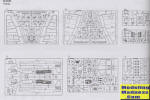 The
Ju-87 has been a fairly popular modeling subject since the first plastic kit
was released by Frog back in 1940. The first mass market version in styrene
was Airfix's 1957 release. Since then, pretty much all major kit producers
have released this aircraf
The
Ju-87 has been a fairly popular modeling subject since the first plastic kit
was released by Frog back in 1940. The first mass market version in styrene
was Airfix's 1957 release. Since then, pretty much all major kit producers
have released this aircraf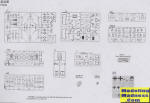 t
in all scales. However, the A model was not a variant that was very popular,
and other than vacuform kits, a proper injection molded kit, albeit a short
run kit, was done by MPM in the mid 1990s.
t
in all scales. However, the A model was not a variant that was very popular,
and other than vacuform kits, a proper injection molded kit, albeit a short
run kit, was done by MPM in the mid 1990s. 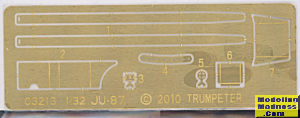 At least
they quit doing the metal control hinges, which were a real pain. All of the
control surfaces are separate, but you are limited to posing them in the
neutral position. This is because the small actuating rods are not molded in
anything but that position and prevent you from posing them otherwise. Wings
are in seven major sections. The inner section includes the lower forward
fuselage and holds the two large wing spars. There are two inner stub wing
sections that fit atop this. Then the outer wings are built up and slotted
over the spars with the fuselage being attached atop that.
At least
they quit doing the metal control hinges, which were a real pain. All of the
control surfaces are separate, but you are limited to posing them in the
neutral position. This is because the small actuating rods are not molded in
anything but that position and prevent you from posing them otherwise. Wings
are in seven major sections. The inner section includes the lower forward
fuselage and holds the two large wing spars. There are two inner stub wing
sections that fit atop this. Then the outer wings are built up and slotted
over the spars with the fuselage being attached atop that. 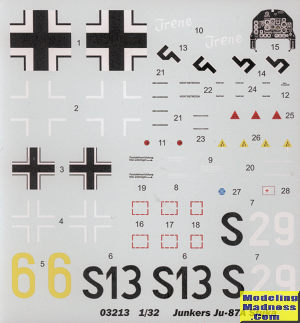 n.
Looking at period photos of this plane on the ground, all show the brakes
raised. For loads, you have a single large bomb for the centerline and on
wing racks smaller bombs, gun pods, or fuel tanks. I'd leave off ALL the
outer wing loads as the A model could really only carry a single bomb due to
its underpowered engine.
n.
Looking at period photos of this plane on the ground, all show the brakes
raised. For loads, you have a single large bomb for the centerline and on
wing racks smaller bombs, gun pods, or fuel tanks. I'd leave off ALL the
outer wing loads as the A model could really only carry a single bomb due to
its underpowered engine. | CONCLUSIONS |
Despite not building all that many Ju-87s, I have done several in the smaller scales. I like the early Stuka and hope to be able to build this one in the near future.
| REFERENCES |
https://en.wikipedia.org/wiki/Junkers_Ju_87#Ju_87A
July 2021 Copyright
ModelingMadness.com. All rights reserved. No reproduction in part or in whole
without express permission. If you would like your product reviewed fairly and fairly quickly, please
contact
the editor
or see other details in the
Note to
Contributors.